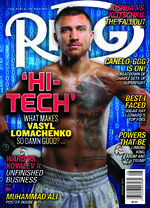Hall of Fame Class of 2017: Evander Holyfield

Induction weekend at the International Boxing Hall of fame in Canastota, New York, will take place on June 8-11.
‘IT’S ABOUT NOT QUITTING’
Something was going on over there, behind that little fence. Something mysterious. Of that Evander Holyfield was quite sure. But what was it?
What was inside that secret world where the only sounds you heard were leather bags being pounded and leather gloves pop, pop, popping when they landed? How do you get in there, anyway? What’s the key?
As things turned out, 8-year-old Evander Holyfield, all 65 pounds of him, already had the key buried deep inside him. No one knew it yet, of course, not even the skinny little kid himself – the one with the big dream of playing for the Atlanta Falcons one day.
No one who saw him thought such a dream possible. Not the smallest kid at the Warren Memorial Boys Club, which was a building full of dreamers set amidst the grinding poverty of Holyfield’s Atlanta neighborhood. Yes, he is quick and agile and relentless, but look at him. Too small, they said, and those doubters were right. Evander Holyfield wasn’t destined to play for the Atlanta Falcons. He was destined for something bigger.
After weeks of begging a stern white man named Carter Morgan to let him inside, Holyfield finally was allowed through the fence that separated football players, basketball players, baseball players and all the other kids from the hardnosed little warriors inside. What he found there would change his life and boxing history.
Evander Holyfield found his home.
For the next 40 years, the boxing ring would be the place where Holyfield found peace even as he made war. He would defeat the greatest fighters of his time, nearly all much bigger than he was, although only on the outside. On the inside, no one was bigger than Evander Holyfield.
“My momma said, ‘If you don’t quit, you’ll get there,’” Holyfield recalled recently. “I listened to her. My coaches would tell me, ‘You didn’t lose. You just didn’t get the decision. You only lose when you stop.’ I didn’t stop.”
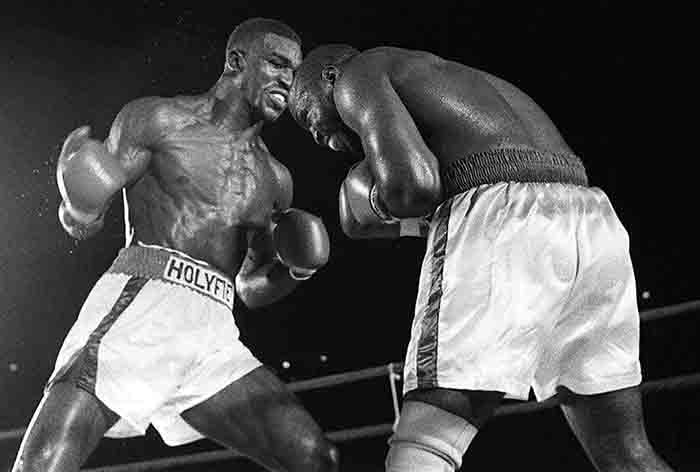
Evander Holyfield (left) vs. Dwight Muhammad Qawi on July 12, 1986 (Photo by Charles Kelly).
Indeed he did not. By the time Holyfield finally retired at the age of 48 (and then again at 51), he’d become one of the biggest names in boxing history. He was not only the greatest cruiserweight of all time, and that division’s undisputed champion when he relinquished the title after defeating Carlos De Leon in 1988 to move up to heavyweight at barely 200 pounds, but he would become the only boxer to win the heavyweight title four times. He had, in the end, not only proven he belonged behind that little fence, but that he belonged in the International Boxing Hall of Fame, where he will be inducted in June.
“I’m honored by it because my work indicates I should be there,” Holyfield said of his election. “When I was 8 years old my coach told me I could be like Muhammad Ali. He told me I could become heavyweight champion of the world. I believed him.
“That was a while ago. I was 8 when I started dreaming and 28 when it happened. I went through a lot for that dream.”
Doubt was one of those things he had to conquer. Not so much selfdoubt, although there was some of that, but more the doubters around him who for so long seemed to see him as less than the fighter he truly was.
But Holyfield fervently believed in himself and in God, who he always felt would protect him even when others feared for his well-being. Holyfield never thought the bargain with God was that he would win, only that He would give him the strength to endure whatever he must. That, when you boil down all that Holyfield became, was his hallmark.
There was no pain he would not endure to win. There was no challenge he would not face to win. There was no fear he would not conquer to win. As talented as he was as a fighter and as gifted as he was in so many ways physically, such that he was able to first win the heavyweight title at only 206 pounds, his greatest strength was his mentality.
Holyfield once said, “If you are not strong mentally, you are not strong anywhere.” No fighter ever did more to prove the truth of that than he did, enduring at 22 the stinging disappointment of being disqualified unfairly in a semifinal bout at the 1984 Olympic Games in Los Angeles. The decision was so absurd that New Zealander Kevin Barry, who was badly beaten but declared the winner, held up Holyfield’s hand. Holyfield accepted that disappointment without complaint.
He would endure a withering, toe-to-toe attack in only his 12th professional fight to take the cruiserweight title away from a rock of a man named Dwight Muhammad Qawi. It was a 15-round fight still considered the greatest cruiserweight match of all time. After unifying the three existing belts two years later, he abandoned the division to move up to heavyweight, a decision few in boxing thought wise because the era of the giant heavyweight had begun. Against men the size of Riddick Bowe, George Foreman, Buster Douglas and later Lennox Lewis, he was a Lilliputian. Of course, his doubters never weighed his heart.
Although by 1988 boxing aficionados had begun to give Holyfield his due, few felt his quest to win the heavyweight title would be fruitful. Lean and sculpted, he looked nothing like the image most people carried of a heavyweight boxer. But he slowly built himself into a 215-pound fighting machine with a chin that could not be dented, a will that could not be broken and considerably more punching power than many thought until they found themselves on the wrong end of his fists.
Twice he was scheduled to face the most feared man in boxing, Mike Tyson, but fate intervened. The first date was June 18, 1990, in Atlantic City. Tyson was the undisputed champion and Holyfield the undisputed No. 1 contender. Tyson was to earn $22 million guaranteed and Holyfield $11 million, which were unheard-of numbers in those early days of pay-per-view, but the fight never happened because Tyson was upset in stunning fashion by Douglas, a 42-1 underdog. Holyfield stood at ringside that day, as stunned as the crowd, and said it didn’t matter because his goal was never to beat Mike Tyson, despite the rivalry dating back to their amateur days.
“I didn’t move up to fight a certain person,” Holyfield recalled. “I became the No. 1 contender but I wasn’t chasing Mike Tyson. I moved up to become undisputed heavyweight champion of the world.”
He would accomplish that for the first time on October 25, 1990, knocking out an out-of-shape Douglas with a thunderous right counter to the nose after Douglas missed an illadvised uppercut in the third round. By then, Holyfield had landed 66 of the first 100 punches he’d thrown and the last one sent the far bigger man to the canvas. There Douglas lay on his back, rubbing his nose with his glove as referee Mills Lane counted him out.
Holyfield had achieved his dream 20 years after first walking behind that little fence, but the world insisted he do more. Until he beat Tyson there would remain a dispute over who was the undisputed baddest man on the planet.
The fight was again set to happen on November 8, 1991, at Caesars Palace when Tyson was indicted on rape charges. Even then it was supposed to go forward but on October 19, Tyson claimed to have suffered a rib injury and the bout was canceled. He was later convicted and served three years in an Indiana prison. All told, it would be six years before they would finally meet and by then many things had changed.
During those years, Holyfield would lose the title to Riddick Bowe in a ferocious fight punctuated by a 10th round in which Holyfield was in significant trouble and looked out on his feet, only to rally back and stagger the bigger man, taking him into equally troubled waters. When the bell sounded to end it, the two slapped each other on the belly, joyous in the mutual carnage they were sharing.
Holyfield would lose a decision that night but won the title back from Bowe in what became known as the infamous “Fan Man” fight – a man literally flew into the ring at the outdoor arena behind Caesars Palace at a time when the momentum was shifting in Holyfield’s favor.
The fight was delayed for some time as chaos reigned near Bowe’s corner, where the pilot and his flying machine had crashed into the ropes and turnbuckle. When order was restored, Bowe seemed unsettled but Holyfield fought on, winning a majority decision and the IBF, WBA and lineal titles a second time.
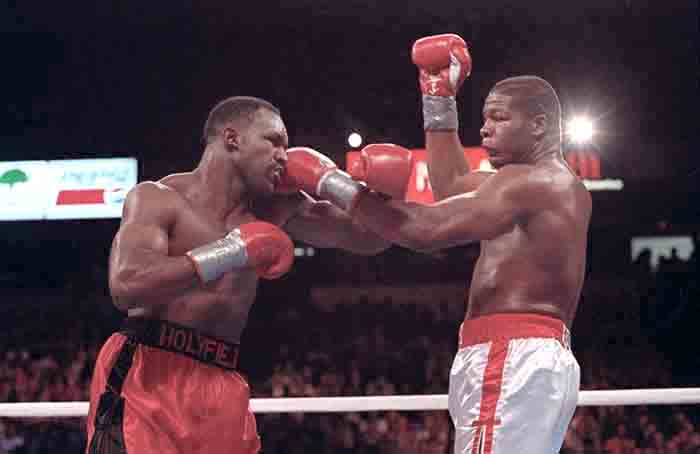
Evander Holyfield (left) vs. Riddick Bowe
He would lose them to Michael Moorer in his next fight, doctors believing his lethargy that night was the result of a previously undetected hole in his heart. Long suffering from chronic problems with dehydration, Holyfield quickly announced his retirement but the doctors’ diagnosis was later found to be incorrect. He claimed to have been “healed” by a televangelist named Benny Hinn during a revival meeting, the “healing” coming not long after he’d written Hinn a large check to aid in his ministry.
Skeptical, the Nevada State Athletic Commission initially refused to license him and later forced him to submit to a battery of tests at the Mayo Clinic. He passed them all without complaint, but after a win over Ray Mercer he was stopped for the first time in his career by Bowe in the rubber match of their classic trilogy. It dropped Holyfield’s record to 31-3 and seemingly sent him into the shadows.
By this time, Tyson was back, but at 34 Holyfield seemed on his way out to many experts. After stopping former light heavyweight and cruiserweight titleholder Bobby Czyz in his next fight but looking lackluster to some while doing it, Holyfield agreed to take $4 million less than his advisers said he was worth to finally get Tyson in the ring on November 9, 1996.
“I’ll get it all back in the rematch after I win,” Holyfield told a friend.
 The boxing world did not share his faith in himself. He was installed as a 25-1 underdog to the WBA titleholder and few gave him even a puncher’s chance of victory. In fact, many feared for his well-being.
The boxing world did not share his faith in himself. He was installed as a 25-1 underdog to the WBA titleholder and few gave him even a puncher’s chance of victory. In fact, many feared for his well-being.
One day about a month before the fight, Holyfield was sitting with a friend in his condo in Houston, not far from the Hard Knocks gym where he trained. Considering all that had happened to him in life, it was a fitting location to prepare for what others thought might be a fistic funeral.
The television was on that day and the image of Tyson’s brash managers, John Horne and Rory Holloway, flashed across the screen. Both were making disparaging remarks about Holyfield and threatening ones about what Tyson would do to him.
Holyfield stopped eating, looked at the TV for a moment and then went back to his plate. Asked what he thought about what he’d heard, he said, “What’s the sense trying to intimidate someone who won’t be intimidated? We still got to fight.”
When they did, Evander Holyfield beat Mike Tyson’s behind. There is no other way to put it.
He staggered him in the second round, cut him above his left eye and then dropped him in the sixth with a left hand to the chest, and badly hurt him near the end of the 10th round, one in which Holyfield landed 23 punches, nearly all of them to Tyson’s head.
The 11th round was merely a formality. Tyson was already swaying when he came out of his corner, his gloves submissively turned inward against his cheeks to protect himself from the assault he knew was coming. But there was no protection.
All the armor of intimidation with which Tyson had beaten so many others had been stripped away. Now he was the one with doubts, although by then even those had been beaten out of him, leaving behind a hollow shell, just as Holyfield expected.
“It will take a special person to beat Tyson,” he’d said before the fight. “You need the ability and the heart. You have to want to beat him. A lot of the others who have fought him had the talent but not the heart. Not just anyone will beat him but I don’t think Mike is unbeatable. He’s human, isn’t he?
“As soon as somebody really decides he wants to be the champion, he can win it. I feel I’m a fighter at heart. I’m out to prove it’s not talk in me, it’s a fight.”
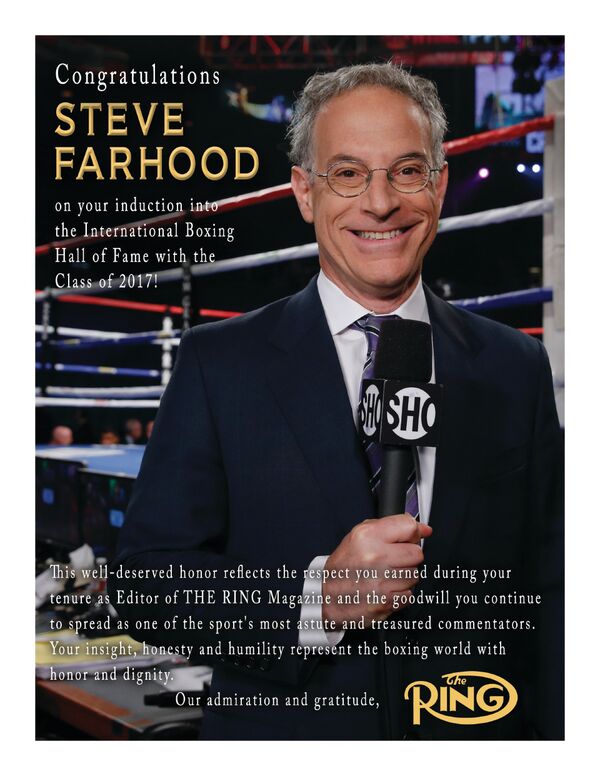
Only 37 seconds after the 11th round began, the fight was over. Holyfield opened a barrage of punches with a stiff right hand that sent Tyson reeling helplessly into the ropes. With Tyson’s body half turned away to shield himself from the blows, referee Mitch Halpern stepped in.
That night Holyfield made only $12 million to Tyson’s $30 million but, as he’d promised, he got it all back in the rematch and then some. He earned $34 million seven months later in the infamous “Bite Fight,” when a frustrated and bleeding Tyson lost his mind and bit both of Holyfield’s ears before being disqualified in the third round.
That was the escape route Tyson chose but the fight was over before it began. When the two engaged in the usual pre-fight staredown as referee Mills Lane gave instructions, Holyfield wore the look of a ferocious lion, hungry for battle, staring a hole through Tyson. Tyson looked away. Barely a minute later, Holyfield rocked him with a right hook, and when Tyson landed his own shots Holyfield was unmoved.
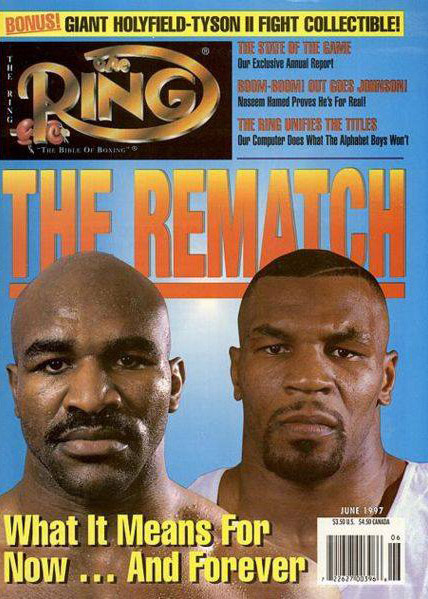 Convinced Holyfield was butting him even though it was he who often led with his head, Tyson lost all selfcontrol while Holyfield remained composed, even as blood leaked down the sides of his face. He did not retaliate, although he later said had the fight gone on it was headed to a dark place Tyson didn’t want to be. Those two fights would be the apex of Holyfield’s career. Although it would go on for 14 more years and 20 more fights, including two with Lewis – a disputed draw and a clear, but close decision for the great British champion in a rematch – as well as a fourth time as a heavyweight titleholder when he won the WBA belt from John Ruiz two months shy of his 38th birthday, so many battles had taken their toll on him.
Convinced Holyfield was butting him even though it was he who often led with his head, Tyson lost all selfcontrol while Holyfield remained composed, even as blood leaked down the sides of his face. He did not retaliate, although he later said had the fight gone on it was headed to a dark place Tyson didn’t want to be. Those two fights would be the apex of Holyfield’s career. Although it would go on for 14 more years and 20 more fights, including two with Lewis – a disputed draw and a clear, but close decision for the great British champion in a rematch – as well as a fourth time as a heavyweight titleholder when he won the WBA belt from John Ruiz two months shy of his 38th birthday, so many battles had taken their toll on him.
Still among the best in the world, he was no longer the best. He was still “The Real Deal,” as he had long been called. But now a tough journeymen like Ruiz or a skillful, elusive boxer like Chris Byrd proved too much for him.
After a trilogy of stylistically ugly matches with Ruiz that led to a 1-1-1 split and Holyfield’s final loss of the title, he would lose three straight to Byrd, James Toney and Larry Donald, temporarily being suspended by the New York Commission for possessing “diminishing skills.” The commission in fact said he’d been “non-competitive” against Donald. Evander Holyfield was many things in boxing but non-competitive was never one of them.
“If no one believes I can do this at 44, so what?” Holyfield told a friend. “They didn’t believe I could do it at 24, either. It doesn’t matter if anybody else believes in me. Criticism is nothing new for me. I am who I am because I stuck with what the word of God says, not what people say. I don’t waver, even with the things I don’t do well. So why should I waver in boxing? Boxing is what I do well.”
He overcame all that through the force of will that had allowed him to ignore so many doubters throughout his career and put himself back into the title picture at 44, only to lose a unanimous decision for the WBO title to Sultan Ibragimov in Russia and a hotly disputed majority one to WBA champion Nikolay Valuev 16 months later.
“I should be the oldest heavyweight champion in history,” Holyfield said with a laugh. “I beat that guy (Valuev). They just didn’t give it to me.”
After losing much of his fortune and eventually his mansion outside Atlanta because of poor business dealings, three divorces and a brood of 11 children, his next three fights were more about the need for money than any progress toward a final title shot. Yet, at nearly 50, Holyfield insisted he was still competitive and willing to face Wladimir Klitschko, who by then ruled the heavyweight division.
Klitschko made it clear that would never happen, so in 2014 Holyfield finally officially retired at 51 having not fought in three years. In the end his record was 44-10-2 (29 knockouts), but those numbers are deceiving. He was 8-7-1 with a no-contest in his final 16 fights, all coming after the age of 37. Prior to that he was 36-3-1 against the biggest and best fighters in what may have been the last great heavyweight era. When all is said and done, Evander Holyfield was arguably the greatest fighter of his time and one of the best heavyweights of all time. The 65-pound kid trying to find a way into the fenced-off, secret world had done more than anyone ever thought possible.
Despite all he did as a heavyweight, however, it is that first meeting with Qawi that he remembers most. That was a test so withering it made him wonder whether boxing really was a trade he wanted to master.
“People always ask, ‘Evander, what was the toughest fight you had?’” he said. “Dwight Muhammad Qawi. He would not STOP! I’d hit him with six shots and he’d come right back with six shots. It was only my 12th fight and people were saying I’d never go 15 rounds. By the end that’s all I wanted to do. I just wanted to make it to the end.
“I wasn’t sure I ever wanted to do that again. My manager, Ken Sanders, showed me the belts. I told him, ‘You can have the belts. I’m too young to die. I don’t want to box no more.’ But I made it. That was my whole thing. I didn’t quit. I made it to the end.”
He did much more than that. He won a split decision in a classic brawl, later beat Qawi easily in a rematch and eventually unified those titles before embarking on a Hall of Fame career as a heavyweight. But he didn’t win every fight, and often it is in losing that a man can have his greatest triumphs. For only then does he truly measure himself. Evander Holyfield, win or lose, always measured up.
“You can’t be four-time heavyweight champion of the world without losing three times,” Holyfield once said. “It’s not about winning or losing. It’s about not quitting.”
One can debate exactly where he fits on the list of boxing’s greatest warriors but no one would ever argue Evander Holyfield quit. He just finally retired, still believing he could win the title one more time but “I can’t make nobody fight.” Perhaps not, but it wasn’t for lack of trying.
EVANDER HOLYFIELD’S GREATEST HITS
The five most important victories in Holyfield’s career:
DWIGHT MUHAMMAD QAWI
Date: July 12, 1986 • Site: The Omni, Atlanta • Result: SD 12 • Background: Holyfield calls this his toughest fight. Qawi was a sort of smaller version of Joe Frazier, a squat, strong whirling dervish. And Holyfield battled him head-on, engaging in some of the wildest exchanges in cruiserweight history. When it was over, Holyfield was declared the winner by a split decision. It was his peak moment at 190 pounds.
BUSTER DOUGLAS
Date: October 25, 1990 • Site: Mirage, Las Vegas • Result: KO 3 • Background: Holyfield was supposed to challenge Mike Tyson for the undisputed heavyweight title but a highly motivated Douglas changed that with his historic upset of Tyson the previous February. That version of Douglas evidently didn’t show up in his first defense, as Holyfield needed less than three rounds to begin the first of his four runs as a heavyweight titleholder.
RIDDICK BOWE II
Date: November 6, 1993 • Site: Caesars Palace, Las Vegas • Result: MD 12 • Background: This fight is remembered most for the “Fan Man,” the idiotic paraglider who crashed into the ring ropes. That overshadows what might’ve been Holyfield’s finest performance, as he outslugged and outlasted his then-unbeaten and much bigger (by 2½ inches and 29 pounds) opponent. Holyfield lost his two other fights with Bowe.
MIKE TYSON I
Date: November 9, 1996 • Site: MGM Grand, Las Vegas • Result: TKO 11 • Background: Tyson was as much as a 25-1 favorite, which was another way of saying Holyfield had virtually no chance. Almost no one believed in him. He did, though. Holyfield not only stood up to Iron Mike’s dangerous advances but responded in kind, ultimately wearing him down and stopping him in the 11th round. It was the biggest victory of his career.
MICHAEL MOORER II
Date: November 8, 1997 • Site: Thomas & Mack, Las Vegas • Result: KO 8 • Background: Holyfield said after a majoritydecision loss to Moorer in April 1994 that he had injured his shoulder in the fight. However, the fact remained Moorer took his title. Holyfield exacted revenge three years later, putting the capable Moorer down five times before finally finishing the job in the eighth round to unify two titles.
RELATED CONTENT ON RINGTV.COM
READ: Class of 2017: Jimmy Lennon Sr.
READ: Class of 2017: Marco Antonio Barrera
READ: Class of 2017: Johnny Tapia
READ: Class of 2017: Eddie Booker
Enjoy this article from THE RING Magazine?
You can subscribe to the print and digital editions of THE RING Magazine by clicking the cover or here. You can also order the current issue, which is on newsstands, or back issues from our subscribe page. On the cover this month: Vasyl “Hi-Tech” Lomachenko.


